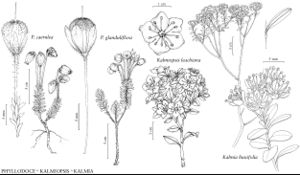Phyllodoce
Parad. Lond. 1: plate 36. 1806 ,.
Shrubs. Stems spreading to erect, (much-branched); young branches usually glandular-hairy, older branches glabrous or puberulent, (roughened peglike projections remaining after fall of leaves, exfoliating). Leaves persistent, alternate; petiole present; blade coriaceous, margins entire, serrulate, or glandular-serrulate, (appearing revolute, abaxial surface less than 1/3 visible). Inflorescences terminal, umbellate, corymbiform, or spikelike clusters, 2–30-flowered, sometimes flowers solitary; perulae absent. Flowers bisexual, radially symmetric, sepals 5, connate basally; petals 5, connate for 1/2+ their lengths, corolla deciduous, urceolate, campanulate, or cylindric; stamens (8–) 10, included or exserted; anthers not awned, dehiscent by terminal slits; ovary 5-locular; style included or exserted; stigma capitate. Fruits capsular, broadly ovoid to globose, dehiscence basipetally septicidal. Seeds 100+, ellipsoid, narrowly winged, not tailed; testa smooth. x = 12.
Distribution
North America, Eurasia
Discussion
Species 8 (5 in the flora).
Selected References
None.
Lower Taxa
Key
| 1 | Corollas yellow or yellowish green | > 2 |
| 1 | Corollas purple, pink, or white | > 3 |
| 2 | Corollas not glandular; filaments glabrous. | Phyllodoce aleutica |
| 2 | Corollas glandular; filaments hairy | Phyllodoce glanduliflora |
| 3 | Corollas urceolate, constricted at mouth, sepals glandular abaxially, margins not ciliate. | Phyllodoce caerulea |
| 3 | Corollas campanulate, not constricted at mouth; sepals glabrous abaxially, margins ciliate | > 4 |
| 4 | Stamens exserted. | Phyllodoce breweri |
| 4 | Stamens included. | Phyllodoce empetriformis |
